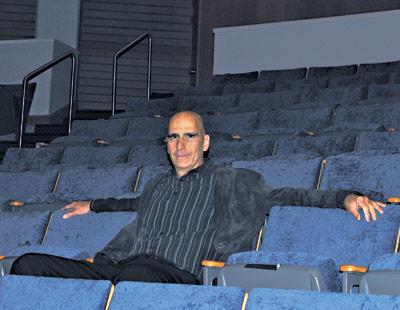Developing New Voices in Theater

There is a feeling of excitement from the Avram Theater to Chancellors Hall at Stony Brook Southampton, the center for Southampton Arts. The burgeoning graduate arts program headed by Robert Reeves has recently added theater to its roster of offerings. There are already M.F.A. degree programs in creative writing and literature. Bringing the theater arts program to Southampton is a natural progression.
“We’re always aware of how much derives from the cultural legacy of the East End,” Mr. Reeves said Monday. “The campus will be something it’s always wanted to be — a cultural mecca.”
Nick Mangano, the chairman and artistic director of the Master of Theater Arts program at the State University at Stony Brook, apologized the other day for the disarray at his new office at the Southampton campus, which is where the program has been recently relocated and expanded under his leadership.
“I moved in this summer but my stuff just arrived,” he said.
The master’s program in theater at Stony Brook is new, with four different tracks: dramaturgy, playwriting, directing, and film. “The M.F.A. in dramaturgy was all that was offered at Stony Brook,” Mr. Mangano said. “With this expanding program, the emphasis is on the creation of new work and to foster unique voices who want to come in and form new collaborations. We’re looking for the entrepreneurial artist.”
Theater offerings at the Southampton Writers Conference, which is sponsored by Stony Brook during the summer, have been expanding, too, with the third annual playwriting conference and a new theater-directing conference this year. Programs in screenwriting and a new digital filmmaking conference this past summer could provide other paths for the school’s graduate arts programs to evolve naturally.
Mr. Mangano is from New York City and graduated from Hunter College there, going on to earn an M.F.A. in directing at Columbia University. He has worked professionally on and off Broadway and is a co-founder of the Garson Theatre Company in Santa Fe, N.M., where he served as artistic director from 2002 to 2005. He lives in Bellport, which he said was exactly halfway between Stony Brook and Southampton.
His own development of an incubator program for new voices came from his personal observations. “When I came into academia,” he said, “I became increasingly aware of this path that many schools seem to offer, with a specialization in getting hired, right when many of the institutions that might hire were dwindling.”
“Artists were no longer driving the bus, they were fitting into a sellable package. It’s impossible to try to find your voice when you’re trying to fit in,” he said.
Mr. Mangano led a tour of the Avram Theater, the Southampton campus’s 429-seat proscenium-style venue. “We have the use of this theater, which has been renovated.” He added, however, that he hoped to renovate a “black box” theater on the second floor, which was padlocked.
“We’re not going to be doing mainstage productions,” he said. The program, he explained, is “not production-oriented; it’s project-driven.”
Initially, the plan is to admit five students in each track, for a total of 20 inaugural students. “This is geared toward the nontraditional student,” Mr. Mangano said.
“We’re also very much aware of where we are located on the East End, with a cross-discipline of artists,” he said, and he looks forward to drawing on some of those artists to lead classes or workshops in the future.
In five years, Mr. Mangano projected, the campus will be home to 60 students, if the three-year master’s program is filled. “We will have artist-teachers who also serve as mentors,” he said, which is a reason why the program will remain at that level of matriculation. “We don’t want to overload the teachers with too many students to mentor, and we certainly don’t want students to be shortchanged. This will be a good ratio.”
Along with the conventional school year, the theater arts program already plans to bring the three-day Michael Chekhov International Theatre Festival to the campus next summer, with more than 50 actors in residence. Stella Adler called Chekhov, the nephew of the Russian playwright Anton Chekhov, “the greatest actor of the 20th century.” He turned to teaching his technique, and his book, “To the Actor,” is required reading in almost every theater program in the nation.
The program is not offering a master’s degree in acting; the students themselves and the artists in residence will perform works by the students. “We want to find like-minded organizations,” Mr. Mangano said. For example, over the summer the Ensemble Studio Theatre visited the campus for three weeks as artists in residence led a series of master classes and workshops.
Mr. Mangano is actively recruiting for the class of 2012; there will be an ad heralding the new, expanded program at Southampton in American Theatre magazine.
His dream? “To have a team of students, or an individual student, that we have fostered — we’ve produced their work in workshops and a full-scale production.” He sees the Southampton theater program as “expanding the community of artists who are creating new work. We want to develop projects here, produce them here, and then hopefully have them go on from here.”
